|
We present the second in a series of 5 articles
THE FIVE LEVELS OF SKILL IN CHEN STYLE TAIJIQUAN
by Chen Xiao Wang translated by Tan Lee-Peng, Ph.D.
The Second Level of Kung Fu
The level starting from the last stage of the first level when one can feel the
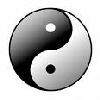
movement of internal energy or qi to the early stage of the third level of kung fu
is termed as the second level of kung fu.
The second level of kung fu involves further reducing shortcomings such as:
Stiff force / jin produced while practising taijiquan
Over- and under-exertion of force
As well as movements which are not well coordinated.
This is to ensure that the internal energy / qi will move systematically in the body
in accordance with the requirements of each movement. Eventually, this should result
in smooth flowing of qi in the body and good coordination of internal qi with external movements.
After acquiring the first level of kung fu, one should be able to practise with ease according to the
preliminary requirements of the movements. The student is able to feel the movement of internal energy.
However, the student may not be able to control the flow of qi in the body.
There are two reasons for this: firstly, the student has not mastered accurately the specific requirements
on each part of the body and their coordination. As an example, if the chest is relaxed downward too much,
the waist and back may not be straight, or if the waist is too relaxed then the chest and rear may protrude.
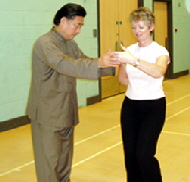 As such, one must further strictly ensure that the requirements on each As such, one must further strictly ensure that the requirements on each
part of the body should be resolved so that they move in unison.
This will enable the whole body to close or unite in a coordinated manner
(which means coordinated internal and external closing / union.
Internal closing implies coordinated union of heart and mind,
of internal energy and force, tendons and bones.
External closing / union of movements implies coordinated closing of
hands with legs, elbows with knees, shoulders with hips).
Simultaneously, there should be an equal and opposite closing movement
of another part of the body and vice versa. Opening and closing movements come together and complement
each other. Secondly, while practising one may find it hard to control different parts of the body all at once.
This means one part of the body may move faster than the rest and result in over-exertion of force;
or a certain part may move too slowly or without enough force, thus resulting in a under-exertion of force.
These two phenomena both contradict the principle of taijiquan. Every movement in Chen style taijiquan
is required not to deviate from the principle of the 'spiralling silk force' or chan-si jin.
According to the Theory of Taijiquan, 'the chan-si-jin originates from the kidneys and at all times is found
in every part of the body'. In the process of learning taijiquan, the spiralling-silk method of movement
i.e. the twining and spiralling method of movement) and the spiralling-silk force
The inner force produced from the spiralling-silk method of movement, can be strictly mastered through
relaxing shoulders and elbows, chest and waist as well as crotch and knees and using the waist as a pivot to
move every part of the body. Starting with rotating the hands anti-clockwis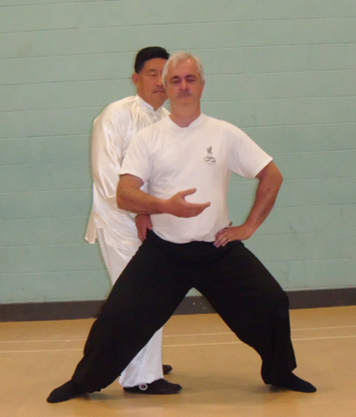 e, e,
the hands should lead the elbows which in turn leads the shoulders
which then guide the waist the part of the waist corresponding to
that side of the should that is being moved.
In actual fact the waist is still the pivot.
On the other hand, if the hands rotate in a clockwise direction,
the waist should move the shoulders, the shoulders move the elbows,
the elbows in turn move the hands.
For the upper half of the body, the wrists and arms should appear
to be gyrating; whereas for the lower portion of the body the ankle
and the thigh should appear to be rotating; as for the trunk,
the waist and the back should appear to be turning.
Combining the movements of the three parts of the body
we should visualise a curve rotating in space.
This curve originates from the legs, with the centre at the waist and ends at the fingers.
In practising the quan, (or the form), if one feels awkward with a particular movement, one can adjust one's waist and thigh according to the sequence of flow of the chan-si-jin to achieve coordination.
In this way, any error can be corrected.
Therefore, while paying attention to the requirement on each part of the body to achieve total co-ordination
of the whole body, the mastering of the rhythm of movement of the spiralling-silk method and spiralling silk
force is a way of resolving conflicts and self-correction for any mistake in practising taijiquan after attaining
the second level of kung fu.
In the first level of kung fu, one begins with learning the forms, and when one is familiar with the forms,
the student can feel the movement of internal energy in the body.
The student may well be very excited and thus never feel tired or bored.
However, in entering the second level of kung fu, the student may feel there is nothing new to learn
and at the same time misunderstand certain important points.
The student may not have mastered these main points accurately and thus find that their movements
are awkward. Or, on the other hand, the student may find that he or she can practise the quan smoothly
and express force with much vigour but cannot apply them while doing push-hands.
Because of this, one may soon feel bored, lose confidence and may give up altogether.
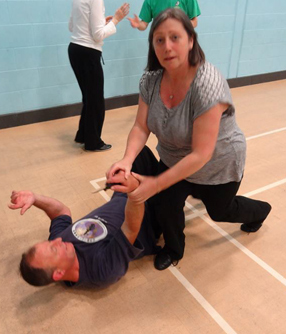
The only way to reach the stage where one can:
produce the right amount of force, not too hard and not too soft;
can change actions at will; and can turn smoothly with ease.
Is to be persistent and strictly adhere to principles.
One has to train hard in the form so that the body movements
are well co-ordinated, and with 'one single movement can activate
movements in every part of the body, thus establishing a complete
system of movements.
There is a common saying,
'if the principle is not clearly understood, consult a teacher;
if the way is not clearly visible, seek the help of friends'.
When the principles as well as the methods are clearly understood, with constant practice, success will prevail.
The Taijiquan Classics state that, 'everybody can possess the ultimate, if only one works hard. And 'if only one persists, ultimately one should achieve sudden break through'.
Generally, most people can attain the second level of kung fu in about four years.
When one reaches the state of being able to experience a smooth flow of qi in the body,
one would suddenly understand it (the command of qi) all.
When this happens, one would be full of confidence and enthusiasm as one goes on practising.
One may even have the strong urge to go on and on and wouldn't feel like stopping!
At the beginning of the second level kung fu the martial art skill attained is about the same as in the
first level kung fu. It is not sufficient for actual application.
At the end of the second level kung fu one is nearing attaining the third level kung fu, as such the
martial skill acquired may be applicable to a certain extent.
The next section introduces the martial skill that should be attainable half-way through the second level
kung fu, so are the third, fourth and fifth levels of kung fu in the subsequent sections.
They are discussed with reference to the skill attainable in the half-way stage in each level.
Push-hands and practising taijiquan are inseparable.
Whatever shortcomings one has in his quan form will show up as weaknesses during push-hands
and thus giving the opponent an opportunity to take advantage of them.
Because of this, in practising taijiquan every part of one's body must be well coordinated with the rest,
there shouldn't be any unnecessary movement.
Push-hands requires warding-off, grabbing, squeezing and pressing to be carried out so precisely,
so that the upper and lower bodies move in co-ordination and it is thus difficult for opponents to attack.
As the saying goes: 'No matter how great is the force on me,
I should mobilise four ounces of strength to deflect one thousand pounds of force'.
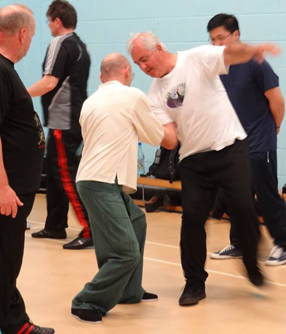
The second level of kung fu aims at achieving smooth flowing of qi
in the body by correcting the postures so as to reach the stage when
qi should penetrate the whole body passing through every joint
as if it (qi) is sequentially linked.
However, the process of adjusting the postures involves making unnecessary or uncoordinated movements.
Therefore: at this stage, one is unable to apply the martial skill at will
during push-hands. The opponent will concentrate on looking for these
weaknesses or he or she may win by surprising one into committing all the
errors like over-exerting, collapsing, throwing-off and confronting of force.
During push-hands, the opponent's advance will not allow one to have
time to adjust one's movements. The opponent will make use of one's
weak point to attack so that one will lose balance or will be forced to step back to ward off the advancing force.
Nevertheless, if the opponent advances with less force and in a slower manner, there may be time or
opportunity to make adjustments and one may be able to ward off the attack in a more satisfactory manner.
Drawing from the above discussion, for the second level kung fu.
Whether one is attacking or blocking-off an attack, much effort is needed.
Very often, it will be an advantage to make the first move, the one who moves last will be at an disadvantage.
At this level, one is unable to 'forget' oneself but 'play along with' the opponent (i.e. not to attack but to yield to the opponent's movement); unable to grasp an opportunity to respond to change.
One may be able to move and ward off an attack but may easily commit errors like throwing-off or
collapsing and over-exerting or confronting [the?] force.
Because of these, during push-hands, one cannot move according to the sequence of warding-off,
grabbing, pressing and pushing down.
A person with this level of skill is described as '20% yin, 80% yang: an undisciplined new hand.'
This next article in the series The 3rd Level of Kung Fu Skill will follow shortly.
We welcome your thoughts on this article why not contact us to discuss them?
View excerpts of the 5 Levels of Taijiquan Skill on Google Books
View the original article
Back to Skill Level 1
Back to Home Page
|